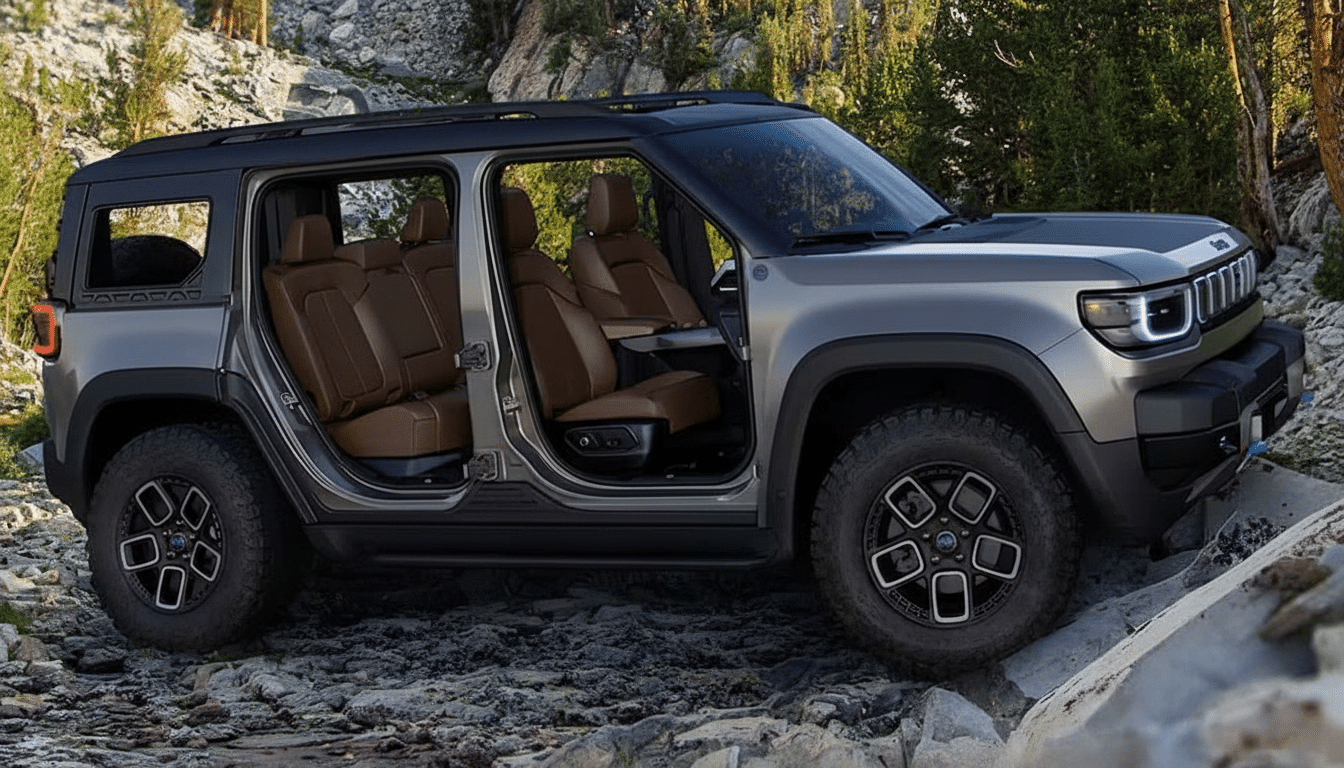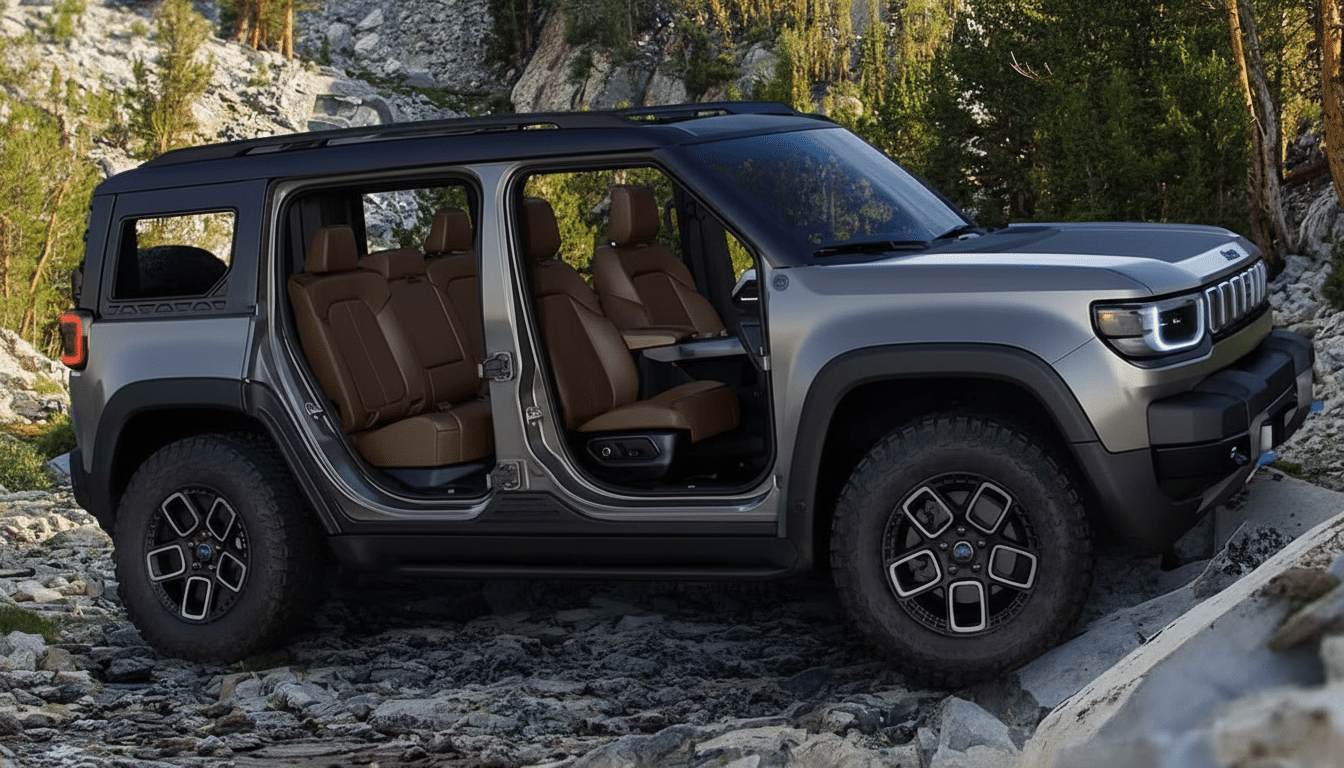Jeep’s short-term battle to win over EV skeptics is no longer a concept. The all-electric Recon is introduced with an estimated 250 miles of range, a price tag that will start at $65,000 before a destination charge of $1,995, and recalling the Toluca Assembly Plant in Mexico for production, with initial deliveries planned for the U.S. and Canada prior to further expansion.
Positioned as a Wrangler-inspired EV meant for actual off-road usage, the Recon rolls up at a time when many automakers are recalibrating electric plans. Which makes Jeep’s commitment to a purpose-designed electric 4×4 interesting and a test of whether traditional SUV buyers are ready to go quiet out on the trail.
- Trail DNA Meets Quiet Torque in a Purpose-Built EV SUV
- Powertrain and Performance Specifications for the Recon
- Charging Capabilities and North American Network Access
- Pricing Context and Target Buyers for the Jeep Recon EV
- Manufacturing Location and Strategic Context for Production
- What to Watch Next as Jeep Readies the Recon for Market

Trail DNA Meets Quiet Torque in a Purpose-Built EV SUV
Jeep has applied its “Trail Rated” seal to the Recon, and equipped it for low-speed rock crawling and sand with Selec-Terrain traction modes, underbody shield protection over the axle and transfer case area, tow hooks, and off-road tires. The rear wheels take power through electronically locking axles that can be enabled with a press of a switch on the body to split torque and grip those loose surfaces where open differentials just spin away energy.
Instant torque is the EV trump card in this one. On technical ground, smooth throttle response and a subtle pedaling action help get the vehicle where it’s needed without wheelspin and gearshifts. The relatively silent powertrain also transforms the off-roading experience — less drivetrain noise, more trail sound — a benefit enthusiasts are increasingly referencing at overland events and owners’ forums.
Powertrain and Performance Specifications for the Recon
Jeep mates a 100-kWh battery to a dual-motor all-wheel drive for an advertised 650 horsepower and 620 pound-feet of torque. The company claims the Recon sprints from 0–60 mph in 3.6 seconds (figures more common to sport sedans than steel-bumpered SUVs). And while that sort of acceleration won’t exactly make a difference on a rock garden, it is indicative of the performance ceiling electric drivetrains bring to the category.
Inside, the Recon debuts Jeep’s biggest infotainment screen ever — a 14.5-inch horizontal touchscreen — along with classic open-air cues such as removable doors, a swing gate, and iconic square LED tail lamps.
And it’s a purposeful combination of ute and tech that reflects where the main 4×4 buyer has been trending.
Charging Capabilities and North American Network Access
Jeep says, for certain models, by way of an adapter, the Recon will support the North American Charging Standard, unlocking access to Tesla’s Supercharger network as it goes from a CCS port. According to the U.S. Department of Energy Alternative Fuels Data Center, Tesla’s footprint has become the largest DC fast-charging network in North America — a practical edge for early owners interested in hitting some road trips.

Exact charging figures (i.e., max DC fast charge rate, 10–80% times, etc.) have not been released yet. That will be key, as J.D. Power’s EV public charging studies show that charge speed and station reliability are the top two satisfaction drivers for those moving from ICE to electric.
Pricing Context and Target Buyers for the Jeep Recon EV
Priced from $65,000 before fees, the Recon is positioned between the entry Wrangler for 2026 (which starts at about $49,895) and luxury electric SUVs like the GMC Hummer EV SUV and Rivian R1S when it comes to typical transaction prices. That middle ground is aimed at shoppers who desire legitimate off-road chops but aren’t ready to cross into six-figure territory.
Jeep isn’t flying blind. The Wrangler 4xe has been the top-selling plug-in hybrid in the U.S. in recent years, according to S&P Global Mobility and company sales reports, suggesting that it’s found an appreciable base of buyers who want electric torque and reduced running costs without forsaking off-road capability. The Recon pushes that argument even further to full battery-electric, the question now being whether you have a convenient place to plug your vehicle in and how committed you are to petroleum abstinence.
Manufacturing Location and Strategic Context for Production
Recon’s location at Toluca, meanwhile, fits Stellantis’ North American manufacturing latticework that has placed a premium on flexibility in the face of evolving demand for EVs. And while some programs in the industry have pivoted to go for extended-range or hybrid solutions, Jeep’s decision to stay on track with a dedicated, Trail Rated BEV — even if it’s due nearly three years from now — helps double down on brand identity: capability first — powered by electrons.
It will initially be available in the U.S. and Canada, with global markets coming next. The United States government has made the standards treacherously hard to meet for such credits: Battery component sourcing and critical mineral sourcing under Treasury guidance will determine eligibility, not just North American assembly — a significant driver of transaction-effective prices.
What to Watch Next as Jeep Readies the Recon for Market
All that is left to round off the rest of the story are EPA-certified range, official charging performance, and trim-specific equipment. Look for Jeep to woo its aftermarketeering faithful with accessories purpose-built for modular doors-off adventures and to leverage software — trail maps, camera views, torque vectoring kicks — to distinguish the Recon from street-oriented EV SUVs.
If it succeeds in converting from Wrangler-curious shoppers and 4xe adopters to full EV drivers, the Recon might soon be one of North America’s inaugural volume off-road BEVs. If it doesn’t, it will still provide a high-visibility test case for how far electric power can stretch a heritage 4×4 badge without diluting the reason that badge means anything in the first place.

